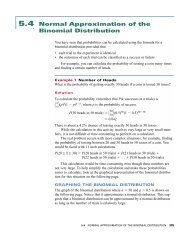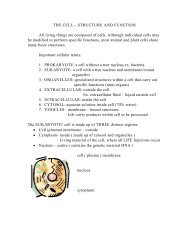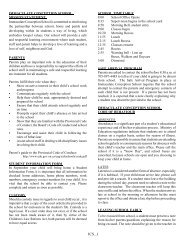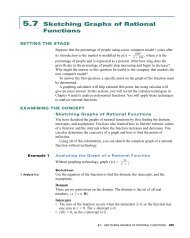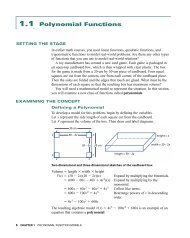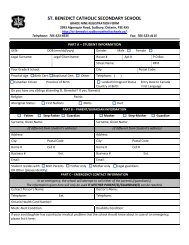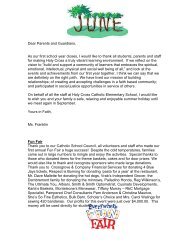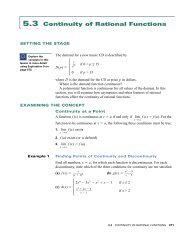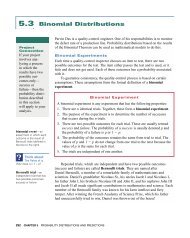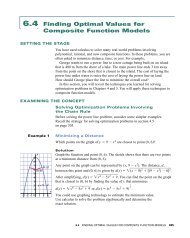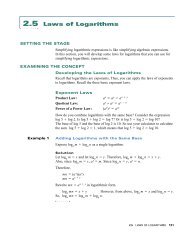5.4 Rate of Change of a Rational FunctionâThe Quotient Rule
5.4 Rate of Change of a Rational FunctionâThe Quotient Rule
5.4 Rate of Change of a Rational FunctionâThe Quotient Rule
You also want an ePaper? Increase the reach of your titles
YUMPU automatically turns print PDFs into web optimized ePapers that Google loves.
12. Salt water has a concentration <strong>of</strong> 10 g <strong>of</strong> salt per litre. The salt water flows<br />
into a large tank that initially holds 500 L <strong>of</strong> pure water. Twenty litres <strong>of</strong> the<br />
salt water flow into the tank per minute. Show that the concentration <strong>of</strong> salt,<br />
10t<br />
c, in the tank at t minutes is given by c(t) 25<br />
, where c is measured in<br />
t<br />
grams per litre. What is the rate <strong>of</strong> change <strong>of</strong> c with respect to t?<br />
13. Application: The concentration, c, <strong>of</strong> a drug in the blood t hours after the<br />
5t<br />
drug is taken orally is given by c(t) 2t 2 . When does the concentration<br />
7<br />
reach its maximum value?<br />
14. At a manufacturing plant, productivity is measured by the number <strong>of</strong> items,<br />
p, produced per employee per day over the previous 10 years.<br />
25t<br />
Productivity is modelled by p(t) t<br />
, where t is the number <strong>of</strong> years<br />
1<br />
measured from 10 years ago. Determine the rate <strong>of</strong> change <strong>of</strong> p with respect<br />
to t.<br />
dy<br />
15. Find d<br />
for y <br />
x<br />
positive.<br />
x 2 1<br />
2x 2 1<br />
dy<br />
. Determine the values <strong>of</strong> x for which d<br />
is<br />
x<br />
C<br />
16. Functions u and v are differentiable functions <strong>of</strong> x, and y u . Determine<br />
v<br />
dy<br />
d x<br />
from first principles.<br />
17. The radius <strong>of</strong> a circular juice blot on a piece <strong>of</strong> paper towel t seconds after<br />
it was first seen is modelled by r(t) 1 2t<br />
, where r is measured in<br />
1 t<br />
centimetres. Calculate<br />
(a) the radius <strong>of</strong> the blot when it was first observed<br />
(b) the time at which the radius <strong>of</strong> the blot was 1.5 cm<br />
(c) the rate <strong>of</strong> increase <strong>of</strong> the area <strong>of</strong> the blot when the radius was 1.5 cm<br />
(d) According to this model, will the radius <strong>of</strong> the blot ever reach 2 cm?<br />
Explain your answer.<br />
(7t<br />
9)<br />
18. Check Your Understanding: The function P(t) 30 models the<br />
3t<br />
2<br />
population, in thousands, <strong>of</strong> a town t years since 1985. Determine the first<br />
and second derivatives. What information do these two derivative functions<br />
give? Explain using numerical examples. Describe the population <strong>of</strong> this<br />
town.<br />
19. Find the equations <strong>of</strong> the tangents from the origin to the graph <strong>of</strong> y x .<br />
x<br />
Sketch the function and the tangent lines.<br />
8<br />
6<br />
20. Thinking, Inquiry, Problem Solving: Choose a simple polynomial function<br />
in the form f (x) ax b. Use the quotient rule to find the derivative <strong>of</strong><br />
1<br />
the reciprocal function ax<br />
. Repeat for other polynomial functions, and<br />
b<br />
1<br />
devise a rule for finding the derivative <strong>of</strong> f (x)<br />
. Confirm your rule using first<br />
principles.<br />
<strong>5.4</strong> RATE OF CHANGE OF A RATIONAL FUNCTION—THE QUOTIENT RULE 385



